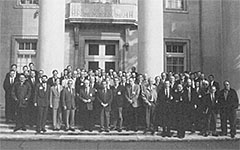Current perspectives in acid inhibitory therapy
 |
|---|
Foreword
The proceedings of the meeting “Current Perspectives in Acid Inhibitory Therapy” provide a unique overview of our present knowledge of the subject. Without the support of By-Gulden, it would not have been possible to assemble this extraordinary group of experts nor produce such a broad assessment of the present state of knowledge in the area of acid peptic disease. On behalf of the Yale School of Medicine and Yale University, I would like to express our deep gratitude to Byk-Gulden both for their generosity and the fine spirit of partnership that underscored the establishment of this symposium.
The subject of acid secretion and digestion is worthy of some consideration. For thousands of years, man has contemplated his place in the universe. The earliest writings address issues of the cosmos and the meanings of life, endlessly examining the nature of divinity, pantheism and the fate of the soul. Nevertheless, throughout these erudite texts runs a common and fundamental issue adumbrated upon both in metaphor and fact – digestion! The commonality of food, the stomach and digestion can be noted in writings as divergent as the Sufi mystics, the Sephardic sages, philosophers of the Tang dynasty or the odes of the Mantuan bard. Food and its digestion represent a theme of human interest equaled only by preoccupation with the ephemeral concept of love. Man is becomes what he eats – Homo est quod est. It is, therefore, no wonder that subject of digestion has been a matter of concern to doctors and their patients for as long as records exist. Human concern about diet and the stomach reflects the dim and dubious origins of rational medicine itself. The Greeks recognized by long experience of trial and error that cooked food was safer than raw; that the sick stomach benefited from a sloppy diet; to defer eating until the decline of a fever; and to strike a sensible balance between gluttony and abstinence. Such early observations established the basis for the initiation of a rational therapy as expounded in the classic comment of Celsius, “In this way, medicine arose from the experience of the recovery of some, the death of others, differentiating the harmful from the salutary things.” The recognition that different kinds of food might engender a lighter mood and relieve melancholy was followed by an appreciation of the relationship of diet to both psyche and soma. In the earliest Greek writings, the efforts of the body to bring the humors from a raw fermented status (apepsia) to normal (pepsis) was associated with the idea of cookery or coction. A view of the digestive processes that survived until well into the seventeenth century!
Up until the time of Beaumont’s studies, the physiology of gastric digestion was obfuscated by a series of mutually contradictory studies, which were best summarized in Hunter’s epigram that the stomach was variously regarded as a mill, a fermenting wine vat or a stew-pan. The identification of gastric acidity as an internally generated event and its relationship to digestion was a phenomenon of the early nineteenth century.
Unfortunately, little rational therapeutic intervention was available for the treatment of gastric disorders. Indeed, up until the late nineteenth century, the stomach was often not clearly recognized as source of symptoms. Nevertheless, from the earliest times, chalk, charcoal and slop diets had been noted t o provide symptomatic relief from dyspepsia. The recognition in this first part of the century that mucosal damage was caused by acid (no acid – no ulcer) and that this acid could be decreased by luminal neutralization resulted in a wave of enthusiasm for antacid preparations, bland diets and milk infusion as therapeutic options. The subsequent identification of the histamine 2 receptor subtype and the development of agents specifically capable of blocking acid secretion revolutionized the management of disease process and virtually obliterated surgery as a therapeutic option for peptic ulcer except in cases of emergency. The more recent identification of the specific molecular mechanism – the proton pump – resulted in the development of a new class of therapeutic agents – the proton pump inhibitors. By precisely defining the pump as the therapeutic target, an almost complete inhibition of acid secretion with consequent therapeutic efficacy, hitherto as yet undreamed of, has been achieved.
Unfortunately, as in all journeys, the horizon may not only appear to recede but further obstacles supervene. Of note, in this respect, was the identification of Helicobacter pylori in the gastric mucosa and its correlation with ulcer disease. It is, thus, likely that abrogation of acid secretion by pump blockade will necessarily need to be supported by the development of pharmacological strategies also designed to eradicate the bacterial pathogen. Implicit in this observation of a novel pathogen was the realization that the historical concept of a “locus minoris resistentiae” might yet apply to the stomach and its environs. Could it be that the mucosa itself might be intrinsically vulnerable or that local repair processes themselves might be flawed and, hence, responsible for inadequate healing?
As one writes this coda, it is clearly apparent that further issues of the mucosal conundrum of damage and healing yet remain to be resolved. In particular, the role of the prolate elipsoid, pepsin and the trefoil motif group of growth factors need clarification. The current status of wound healing of the mucosa is probably best reflected in the adage of the great French surgeon Ambroise Paré, “Je le pansy, Dieu le guarit.” Nevertheless, great progress has been made and, as this meeting proceedings will show, much has been accomplished.
Irvin M. Modlin
Vault de Lugny, 1996